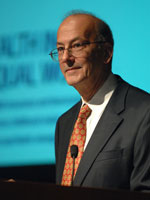Planning to meet future global health needs
May / June 2012 | Volume 11, Issue 3

Dr. Roger I. Glass,
Director of the Fogarty
International Center
Opinion by Dr. Roger I. Glass
Director, Fogarty International Center
Capacity building is a long-term process. It's often years or even decades before we see the tangible results from our trainees in terms of the scientific discoveries they are able to make, and the multiplier effect as they, in turn, train additional researchers.
That's one reason it's vital that we at Fogarty periodically spend some time listening to our stakeholders to assess the current research and training gaps and make projections about the kinds of knowledge, skills and subject matter expertise that will be essential for global health researchers five or 10 years from now.
We last revised our strategic plan in 2008, when we comprehensively reviewed the landscape for global health research and training and developed a set of goals. While much has been accomplished over the last five years, many challenges remain. And, of course, some circumstances have changed. We view this round of strategic planning as an opportunity to review and refresh our goals, without making a major change in direction.
We'd like to capitalize on the tsunami of interest in global health we're witnessing on campuses across the U.S. We've revamped our Fogarty Fellows and Scholars program to focus more attention on providing postdocs with a foreign research experience. We also must recruit participants with expertise in diabetes, mental health, oncology and other fields if we are to build the next generation of global health leaders needed to prevent and treat the rising tide of chronic, non-communicable illnesses.
Advances in communications technology are also of great interest to us and the global health community. How can we better integrate information communications technology into our programs? mHealth receives a lot of attention but there is little evidence to indicate how it can be implemented to improve health. Is this something we can help tackle? Many of our grantees have developed distance learning components for their research training programs. Are there ways we can coordinate and promote these resources to maximize their impact and reduce redundancies?
The world's emerging economies - such as Brazil, Russia, India and China - now have highly developed biomedical enterprises that present new opportunities. These countries have reached the stage where they're able to become equal research partners with NIH, with each side paying its own way but working together and sharing expertise to speed discoveries.
Another new collaboration is our Medical Education Partnership Initiative, which is intended to strengthen sub-Saharan Africa's medical schools. All the participants are linked together so they can leverage resources and exchange best practices. How can we strengthen the MEPI network and attract new partners to bring additional expertise and support?
At Fogarty, we strive to be a catalyst, drawing attention to a critical issue or unmet need, providing seed money that will mobilize others to join in. We like to think we add value by making connections, facilitating international collaborations and bringing a variety of players with mutual interests together to solve a problem. What are some of the issues we should address in the future?
We also believe Fogarty plays a vital role as a convener, bringing the best scientific minds to bear on a particular topic. For instance, over the past few years we have assembled the world's experts to grapple with tough issues such as polio eradication and artemisinin resistance that threatens our progress against malaria. Our epidemiology division provides timely analysis and modeling of influenza, malaria and other disease topics. What are the critical research gaps they should study next?
These are all important and complex issues to address. I welcome your thoughts and suggestions to help guide us in our planning so that, together, we can meet the challenges ahead.
Please send your comments and suggestions by June 30, 2012 to FICStratPlan@mail.nih.gov.
More Information
To view Adobe PDF files,
download current, free accessible plug-ins from Adobe's website.